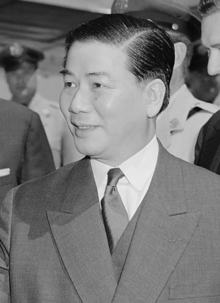
| ||
|---|---|---|
Prime Minister of the
State of Vietnam (1954–1955) President of South Vietnam (1955–1963)
Policies and theories
Major events
Elections
Diplomatic activities
Family
 |
||
The Ngô Đình Diệm presidential visit to Australia from 2 to 9 September 1957 was an official visit by the first president of the Republic of Vietnam.[1] It was part of a year of travelling for Diệm, who made official visits to the United States and other anti-communist countries.[2] As with his American trip, Diệm was warmly and lavishly received during the height of the Cold War, garnering bipartisan praise from both the Liberal Party of Australia of Prime Minister Robert Menzies and the opposition Australian Labor Party (ALP).
Diệm addressed the Parliament of Australia and was made an honorary Knight Grand Cross of the Order of St Michael and St George, one of the highest imperial honours that can be bestowed on a non-British subject—at the time, Australians were also British subjects. Diệm did not engage in substantive political discussions with the Australian leaders and he spent most of his time at public functions. He was universally extolled by the media, which praised him for what they perceived to be a successful, charismatic, democratic and righteous rule in South Vietnam, overlooking his authoritarianism, election fraud and other corrupt practices. The Australian Catholic leadership and media were particularly glowing towards the South Vietnamese head of state. A member of Vietnam's Catholic minority and the brother of Vietnam's leading archbishop, Diệm had pursued policies in Vietnam favoring his co-religionists. He exempted the Catholic Church from land redistribution, gave them more aid and job promotions, and allowed Catholic paramilitaries to attack Buddhists, who formed the religious majority.
Diệm's visit was a highmark in relations between Australia and South Vietnam. Over time, Diệm became unpopular with his foreign allies, who began to criticise his autocratic style and religious bias. By the time of his assassination in 1963, he had little support. Australia later sent troops to support South Vietnam in the anti-communist fight, but the bipartisanship evaporated during the mid-1960s as the ALP began to sympathise with North Vietnam and opposition to the Vietnam War grew. The ALP later withdrew support for and refused to accept refugees from South Vietnam after winning office, but on the return of the centre right Liberal-National coalition to power in 1975, Vietnamese refugees were allowed to resettle in Australia in large numbers.
